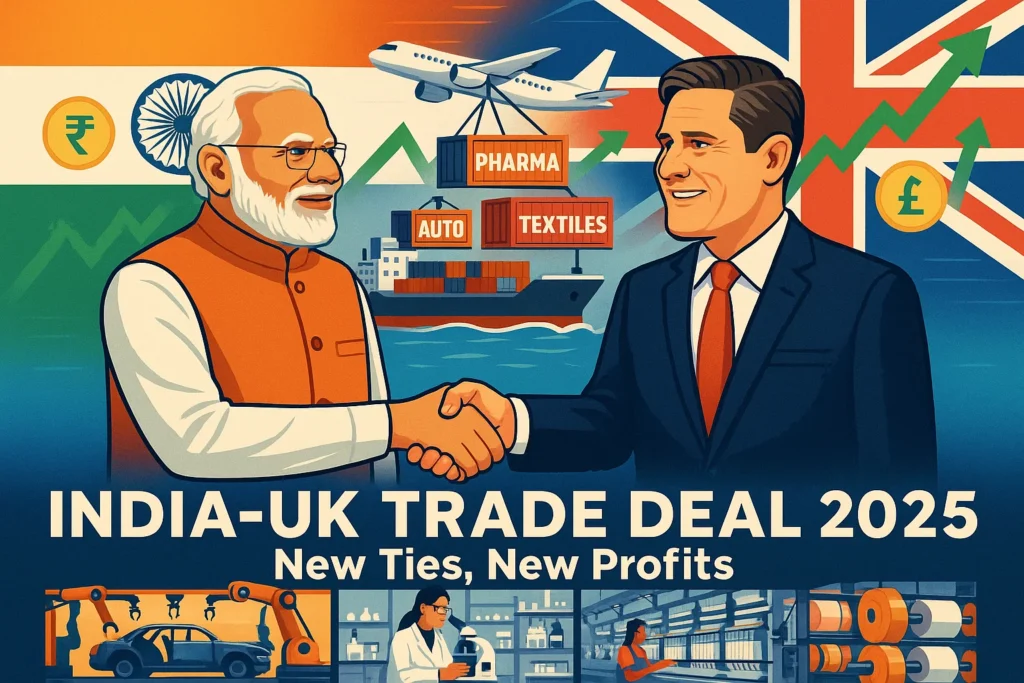Introduction: India-UK Trade Deal Is Finally Here
The India-UK Trade Deal is finally sealed—and it’s not just another diplomatic handshake. On May 6, 2025, Prime Minister Narendra Modi announced that the long-pending Free Trade Agreement between India and the United Kingdom is officially finalized.
This is big. This is historic. And yes, this is profitable—especially if you know where to look in the stock market.
While the UK seeks post-Brexit economic partners, India is racing toward becoming the world’s fourth-largest economy by the end of 2025, according to the IMF. With Indian exports already crossing $820 billion in FY25, this deal comes at the perfect time.
So what does this trade deal actually mean for investors? And which Indian companies could ride this wave? Let’s break it down.
What Exactly Is a Free Trade Agreement?
In simple terms, a Free Trade Agreement (FTA) is a deal between two countries to make trading easier by cutting down taxes (tariffs), restrictions, and red tape. It helps businesses sell their products in each other’s markets with fewer obstacles.
India has already signed FTAs with countries like UAE, ASEAN, and Australia. But this one’s different.
This is India’s first full-scale trade deal with a major Western economy, and it covers not just goods but services, skilled workers, digital trade, and even joint R&D and public procurement.

Today, the UK is the sixth-largest investor in India, while India has become the second-largest foreign investor in the UK. Over 900 Indian companies operate in Britain, employing more than 100,000 people. This deal is about scaling that relationship—fast.
📌 Stocks to Watch (Trade Enablers):
With trade volumes set to jump, expect higher demand for logistics and port infrastructure.
Indian companies that could benefit include:
- Adani Ports & SEZ – dominant player in port operations
- Container Corporation of India (CONCOR) – India’s rail logistics backbone
- Allcargo Logistics – global logistics company with a strong UK presence
Modi’s Big Announcement: What He Said on May 6, 2025
Prime Minister Modi declared on May 6:
“The India-UK Free Trade Agreement has been finalized. It marks a new chapter in our economic and strategic partnership.”
Behind that statement were 15 rounds of negotiations, months of haggling, and pressure from business lobbies on both sides.
This deal eliminates tariffs on almost 99% of Indian exports to the UK. It will slash costs for Indian businesses and give easier access to a premium market hungry for affordable, high-quality goods—from auto components to pharmaceuticals.
The announcement also comes just as India is pushing to finalize similar deals with the EU, Canada, and Gulf nations, showing the world that India is no longer playing defense in global trade—it’s going full throttle.
Inside the India-UK Trade Deal: What’s In It for India?
Now that the handshake has happened, let’s look beyond the photo-op and dive into what this deal actually includes. Because here’s the thing — this isn’t just about lowering tariffs. It’s a strategic roadmap touching almost every corner of India’s economy.
Tariff Cuts: The Real Gamechanger
Under the deal:
- 90% of UK product lines will see Indian tariff reductions.
- 85% of those will be completely tariff-free in the next 10 years.
- On the other side, 99% of Indian goods entering the UK will now face zero tariffs.
That’s a monumental shift. British whisky, gin, medical equipment, and luxury cars will be cheaper in India. Meanwhile, Indian textiles, auto parts, leather goods, and jewellery will flood into the UK at highly competitive prices.
📌 Stocks to Watch (Tariff-Boosted Exporters):
- KPR Mill, Welspun India, Arvind Ltd – Textile giants ready to ride the UK demand wave
- Bharat Forge, Sundaram Fasteners – Auto component exporters that already serve global OEMs
- Titan Company – Jewellery sales abroad (especially in the UK) are set to rise with duty cuts
- KEI Industries, Polycab India – Engineering and wire & cable exports get a fresh edge
Sensitive Sectors Stay Shielded
India has drawn a red line around rural and sensitive sectors—no tariff cuts on:
- Dairy, poultry, apples, cheese, pig meat, eggs, and even sugar.
This was crucial for Indian farmers and rural economies. India has learned from other countries where unchecked imports damaged local industries. This time, it’s playing smart.
📌 Stocks to Watch (Defensive Agri Plays):
- Hatsun Agro, Parag Milk Foods – Safe from competition in dairy
- Venky’s, Godrej Agrovet – Poultry players breathe easy
- Heritage Foods, Avanti Feeds – Protected from low-cost UK imports in their categories
Professionals & Visas: New Passports to Growth
Here’s one of the most overlooked benefits: the deal liberalizes visa norms for professionals. Engineers, architects, accountants, and consultants from India will find it easier to move to and work in the UK for short-term projects.
Also:
- No social security payments for 3 years for temporary Indian workers in the UK (and vice versa).
- Easier intra-company transfers and conference visas for high-skilled talent.
This is a massive win for India’s services sector, especially IT, consulting, and tech outsourcing.
📌 Stocks to Watch (Services & Talent Exporters):
- TCS, Infosys, Wipro, Tech Mahindra – All benefit from smoother mobility for professionals
- L&T Technology Services, Cyient – Engineering and R&D export leaders that gain access to UK contracts
- Quess Corp – Staffing company positioned to provide skilled Indian talent to the UK
Public Procurement: “Make in India” Meets “Buy in Britain”
The UK will now get access to India’s government procurement markets in:
- Infrastructure
- Construction services
- Engineering and public projects
And it’s reciprocal — Indian firms can now bid for UK government contracts, something previously blocked by restrictive policies.
📌 Stocks to Watch (Public Infra & Project Bidders):
- Larsen & Toubro – India’s biggest infra giant, now gunning for UK contracts
- KNR Constructions, IRB Infrastructure – Niche infrastructure plays likely to benefit
- BHEL, BEL – PSUs with deep experience in engineering contracts now have cross-border opportunities
Labour, Women, and Anti-Corruption Measures
For the first time in an Indian FTA, we see chapters focused on:
- Labor rights
- Women empowerment
- Anti-corruption
- Consumer protections
Yes, it’s more than trade—it’s a socio-economic agreement designed to foster fair, equitable, and transparent growth.
This matters because international buyers are increasingly focusing on ethical sourcing and ESG metrics. Indian companies that follow best practices will have a bigger export advantage.
📌 Stocks to Watch (High ESG-Score Companies):
ITC – Rural-focused empowerment and farmer supply chains with ESG-conscious branding
Tata Consumer, Hindustan Unilever – Leaders in ESG and sustainability
Infosys, Wipro – Known for ethical corporate governance and inclusive hiring
Big Picture Impact: How This Trade Deal Reshapes India’s Economy
It’s tempting to view the India-UK trade deal as just another bilateral agreement. But this one is different. It’s strategic, not just transactional. The numbers behind it? Even more telling.
Let’s break it down.
🇮🇳 + 🇬🇧 = $120 Billion Dream
Before the deal, India-UK bilateral trade stood at $20.36 billion (FY24).
Now, both countries are aiming high — $120 billion in trade volume by 2030.
That’s nearly a 6x jump in just 6 years.
How is that even possible?
Because this deal unlocks:
- Faster customs clearances
- Zero-duty access for critical sectors
- Professional mobility
- Services exports (India’s secret weapon)
And remember: The UK isn’t just one market. It’s India’s gateway to Europe, R&D collaboration, and finance capital. In short, it’s not just about selling sarees and steel — it’s about grabbing a chunk of the premium value chain.
📌 Sectors Set to Gain Big:
- Textiles & Garments – Fast Fashion exports to UK retailers
- Pharma & Biotech – More clinical trials, lower trade barriers
- Tech Services – Cloud, AI, and FinTech contracts from UK firms
- Gems & Jewellery – Especially in the wedding and luxury segment
- Processed Food & Agri Value Chains – Premium Indian brands entering British supermarkets
GDP & Investment Boost: The Ripple Effect
A report by the UK’s Department for Business and Trade (DBT) estimates:
- India’s GDP could get a 1.5% bump from this FTA by 2035.
- UK’s GDP might grow by £3.3 billion as a result.
- Job creation? Thousands, on both sides.
More importantly, this deal is a trust signal to global investors.
When two major democracies create an FTA with progressive chapters like digital trade, anti-corruption, and ESG, it tells global capital one thing: India is open, serious, and competitive.
📌 Stocks to Watch (FTA-Confidence Beneficiaries):
- ICICI Bank, SBI, HDFC Bank – Increased capital flows and NRI banking demand
- Kotak Mahindra AMC, Axis Mutual Fund – Global capital may look at India-focused UK ETFs
- HDFC Life, ICICI Prudential – Insurance FDI from UK could rise
Export Surge: Sectors That Could Boom
The UK is already India’s:
- 7th largest export destination
- 4th largest inward investor
Post-deal, India’s exports to the UK are projected to grow at CAGR of 10–12%, led by:
| Sector | FY24 Exports (₹ Cr) | Post-Deal Growth Potential |
|---|---|---|
| Gems & Jewellery | 20,300 | +25% in next 2 years |
| Apparel & Textiles | 14,000 | +30% over 3 years |
| Auto Components | 9,700 | +20–25% |
| Pharmaceuticals | 8,000 | +15–20% |
| IT Services | ₹42,000+ | +12–15% |
📌 Midcap Exporters to Track:
- Ethos Ltd – Luxury watch retailer likely to benefit from UK tie-ups
- Stove Kraft, Borosil – Premium kitchen appliance makers with export ambitions
- Vaibhav Global – Direct jewellery sales into UK via online retail
The Strategic Numbers: Not Just Economics, It’s Diplomacy
Think about it:
- India signs a trade deal with a G7 nation amid rising global protectionism.
- The UK gets access to the world’s fastest-growing middle-class market.
- India gets a seat at the Western trade table just before its 2025 WTO showdown.
It’s not just about GDP. It’s about leverage. And that leverage is now visible in India’s economic diplomacy.
👉 Start your investing journey with Angel One today
Market Reaction & Sectoral Shifts: The Surprising Impact of the India-UK Trade Deal
The India-UK Trade Deal was widely anticipated to cause ripples across various sectors, with early forecasts suggesting that some industries would thrive while others could face challenges. As with any trade agreement, the real story often lies in the details, and this deal proved to be no exception. While there were initial assumptions about sectors like textiles gaining momentum and alcohol stocks facing a boost, the actual market response turned out to be far more nuanced.
Textiles: An Unexpected Boom
In the lead-up to the agreement’s finalization, textile stocks were expected to take a hit. The general fear was that the UK’s textile exports would flood the Indian market, pushing local producers into a corner. Instead, the reverse happened. Indian textile stocks actually saw a surge in value post-deal. This was because the India-UK Trade Deal provided Indian textile manufacturers with preferential access to the UK market, leading to a boom in exports. Value-added textile segments such as premium apparel and home furnishings received an unexpected push, as the UK market opened wider for Indian exports.
Rather than becoming a victim of cheaper imports, Indian textile companies found themselves in a better position to sell their products in the UK, where demand for high-quality, affordable alternatives to European goods is on the rise. Stocks like Raymond, Arvind, and Vardhman Textiles benefited from increased global market access, driving their valuation higher than anticipated.
Alcohol: The Expected High That Didn’t Quite Materialize
On the other hand, alcohol stocks seemed to have a different journey. The India-UK Trade Deal had initially sparked hopes that duty-free access to Scotch whisky and other premium spirits would unlock a wave of growth for alcohol brands in India. However, reality didn’t align with the hype. The Indian market for alcohol, though large, is already highly competitive, and local preferences often outweigh imported goods, especially in the case of spirits like Scotch whisky.
While the reduction in tariffs certainly made imported alcohol slightly cheaper, the market’s initial excitement quickly turned to a more muted response. Companies like United Spirits did experience some benefit from the FTA, but the growth was less dramatic than expected. The saturation of the Indian alcohol market and a stronger inclination toward local brands restrained the kind of explosive growth that analysts had forecasted.
Even more surprising was the reality of India’s consumer behavior post-pandemic, where luxury spending—especially on imported spirits—did not see the anticipated rise. This, coupled with regulatory hurdles and logistical challenges around alcohol imports, led to a more subdued market response. The excitement wore off, and alcohol stocks didn’t show the upward trajectory that many had predicted.
So, What Happened? Why the Market Response Was Different?
This dichotomy in performance—textiles thriving while alcohol stocks faltered—is a classic example of how market psychology and fundamental economic realities can often differ from initial expectations. In the case of textiles, the export boost to the UK market was a far more significant driver than anticipated, especially for value-added goods. On the other hand, alcohol stocks, despite tariff reductions, were restrained by factors like saturation, local competition, and shifting consumer habits.
This market reaction highlights how trade agreements—no matter how promising they may seem on paper—are subject to real-world dynamics. In the case of the India-UK Trade Deal, the shift in market sentiment was less about the immediate financials and more about long-term consumer preferences, global export opportunities, and sector maturity.
Conclusion: A Future of Growth and Global Integration
In conclusion, the India-UK Trade Deal holds immense potential for both countries. While the immediate market responses have shown surprising results, the deal’s long-term implications are far-reaching. It offers India a chance to strengthen its economic ties with one of the world’s leading economies, while also creating new opportunities for growth in technology, agriculture, renewable energy, and more. For investors, this means a whole new world of possibilities, from enhanced export opportunities to emerging sectors ready for growth.
As we look ahead, the success of the India-UK Trade Deal will depend on the ability of both nations to navigate challenges, adapt to global changes, and leverage mutual strengths. For now, the road is wide open, with new horizons for both India’s economic growth and global market positioning.
Related Articles
Natural Hydrogen Fuel: Could It Power the Future of Clean Energy?






